Modding
| Buckle your seatbelt, Dorothy… |
|---|
| This article is classified long as fuck. |
Usually, modding is the process of shitting all over the hard work that the game developers put in their games. Most of the time it comes down to adding visual changes that don’t match the style of the game or making the player overpowered because they can’t be assed to actually play the game.
The another type of modding is adding custom storylines, which is the case for HPL games. Around 90% of all mods are crappy pieces of shit that look like they were made by a twelve year old (which they sometimes are).
Many mods are genuinely enjoyable and nice-looking, but before you find them, the shitty ones likely have already irreparably warped your expectations enough to not bother playing.
 |
|---|
| A decent example of the quality often considered sufficient by modders and ModDB users. |
Why most mods are garbage
Making mods is fucking hard work.
And a very laborious endeavor – a good mod can take months to make, sometimes even years, so lots of persistence is needed. Although if it takes you more than a year to make a mod, you’re either doing something terribly wrong or need to seriously re-evaluate your scope.
A modder must also be at least somewhat competent in programming, storywriting, as well as puzzle and level design. To go beyond the absolute basics they have to be able to research things without being held by the hand.
As you can expect, most of these are not common among modders. The average modder:
- Has difficulties following basic instructions given in tutorials
- Will not use documentation (reading is hard)
- Scripts levels by copy-pasting code from tutorials
- Will mostly use corridor layouts for their levels
- Won’t use any special effects (e.g. dust in the air, ambient light)
- Doesn’t accept feedback
- Will write an unoriginal, cliche and contrived story
Main article: Modders
Lastly, most modders either give up after their first shitty mod or refuse to learn and never improve.
- Am I immediately good at this?
- No.
- Then I’ve lost interest.
Writing

Amnesia mods are populated by unique, one-of-a-kind stories about spooky mansins/castles/dungens.
The average modder will do some of the following in their story:
- Leave tons of errors in the writing
- Rip-off major plot elements from The Dark Descent without noticing it
- Write about the protagonist’s “femily” being kidnapped
- Make an “escape mansion” plot
- Start the mod with the main character waking up with amnesia
- …possibly all of the above simultaneously
 |
|---|
| I went on ModDB while writing this article and this was the first mod on the list. |
 |
|---|
| This was a bit lower on the main page as well. |
Because voice acting requires co-operation and ideally paying someone, most mods portray characters only in text. On the rare occasion that there is VA in the mod, it will usually be a flat delivery with a heavy accent and sound like the “actor” is trying to not get heard by their mum. These are also recorded with shitty microphones and sometimes contain a comical amount of noise.
 |
|---|
| “Infromation” (in1970) |
Furthermore, even good mod creators have no idea how to write characters. Typically they are just exposition delivery machines and have no discernible wants, needs or personality traits.
As a result of having a cast of cardboard cut-outs, mod plots are very forgettable. In fact you will probably find yourself forgetting the plot while still playing the mod.
Gameplay
Mod gameplay is often very repetitive (surprise) and completely forgoes using half of the main game mechanics.
Scripting
Most modders don’t want to bother learning how to program. At the same time they want to make mods though, so they must script events and puzzles. As a result, these people mostly copy puzzles and events from tutorials.
The events are often rudimentary, using the most basic scripts such as spawning or despawning an object, playing a sound or spawning a monster. Typically, events will happen upon picking up an item (it is the simplest way of triggering an event), making it completely predictable to the player.
The puzzles usually come down to finding items and using them on an appropriate object (mainly keys and doors). As such, mod gameplay mostly consists of searching for items (“item hunting”/”key hunting”) and running to the spot where they’re supposed to be used. This can result in short playtimes, so the items are often hidden in exceedingly annoying places and/or at large distances from their destination.
You can imagine how fun repeatedly “solving” these “puzzles” is. Somehow though, some people enjoy it without their brains leaking out their ears.
Physics
Sometimes modders remember that one of Amnesia’s key selling points was physics manipulation. Its usage will usually end with stacking boxes to jump over an obstacle though. Admittedly however, even Amnesia’s creators have ran out of ideas for physics-based puzzles after making Penumbra.
Resource management
One of Amnesia’s core mechanics was managing sanity by staying out of darkness. Typically, lantern oil was scarce and the player would use tinderboxes to light various light sources. To make that work, the levels have to be populated with unlit lamps and candles. There is even an entire system which allows multiple light sources to contribute to the overall light level in a room.
However, basically all modders (even the best) never leave any room for tinderbox usage, let alone use the room system. Unlit light sources are rare and usually placed nearby already lit areas, basically voiding the mechanic. Resource management is simplified to portioning lamp oil, with tinderboxes ending up a pointless collectible. Some modders don’t even bother with that and give the player huge amounts of oil, which effectively removes all resource management from the game.
Level design
Most 3D games at their very core are basically sightseeing tours. If the levels suck, very few things can save a game or a mod. Level design could be discussed at extreme lengths, but let’s focus on some of the most apparent issues that plague mods.
Mansionbase
One of the most telling symptoms of a shitty mod is the incessant use of mansionbase.
While this asset pack is pretty much everyone’s favorite and can lead to some of the best designs made by the community, it is often the only one used by moders1 to make “mensons” and “mansins”. Occasionally, the particularly adventurous ones will use something else for the inevitable scary cellar level.
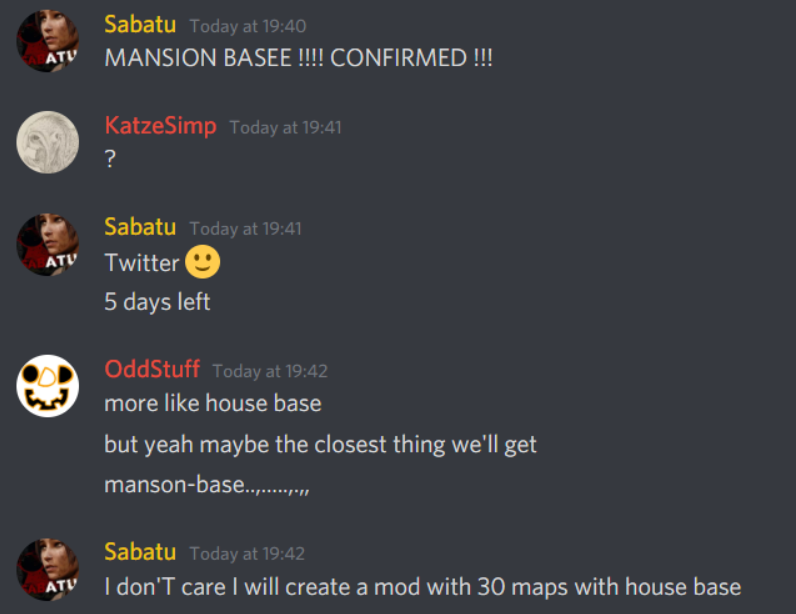 |
|---|
| Sabatu almost cumming after seeing something mildly resembling a mansion in an Amnesia: Rebirth teaser. It’s unsure if he was joking about the 30 maps thing |
Lighting
Many modders do not light their levels at all.
The only light in such levels comes from lamp models, which have lights attached to them. They were however made with the assumption that more lights will be used to create a finely-tuned effect. The issue is especially apparent due to a lack of ambient light, which ends up looking like a toddler spilled black paint on their drawing:
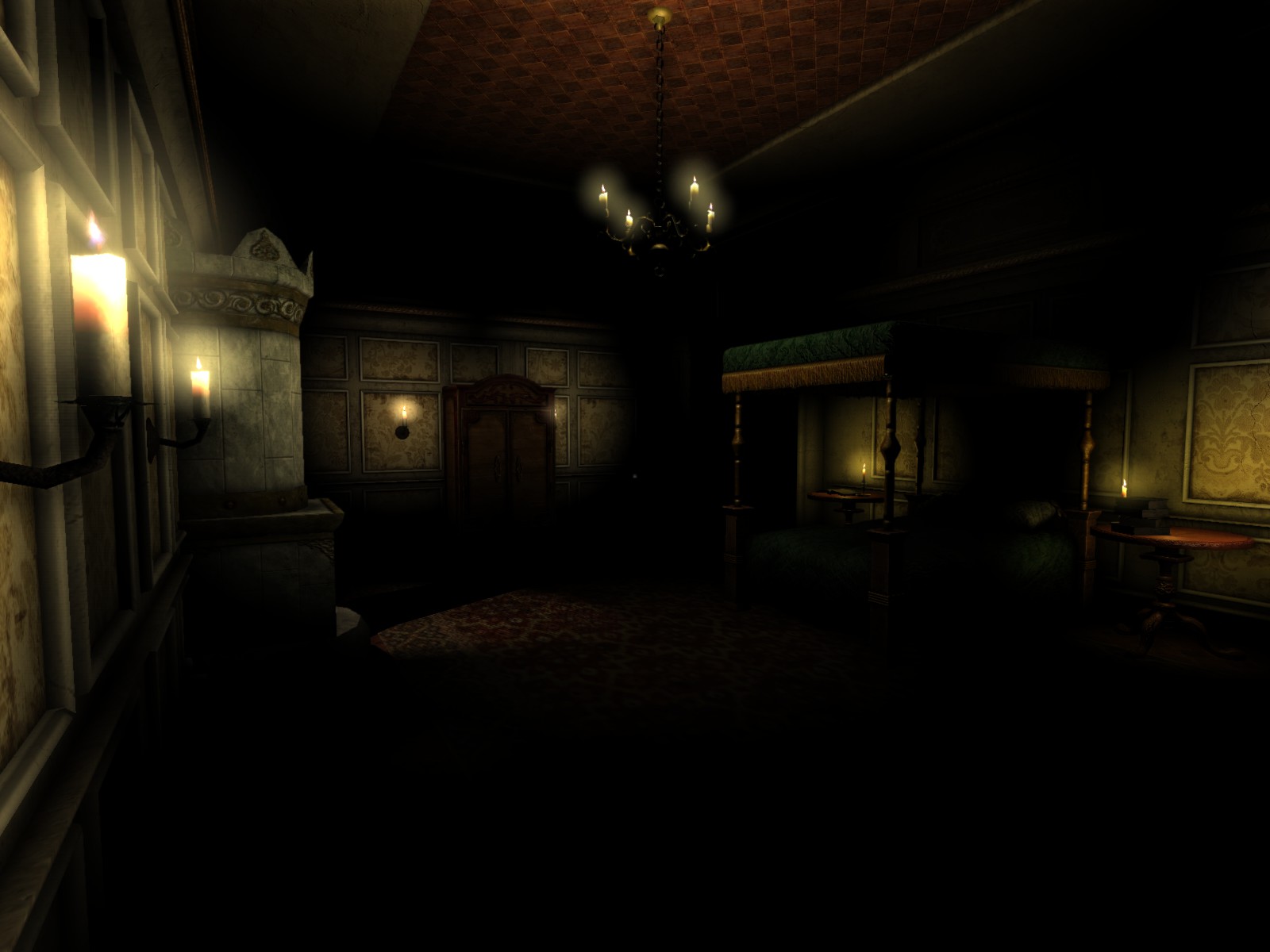 |
|---|
| This is not how light works. |
The people who do this usually give the player more lantern oil than they need, which ends up with the lantern being turned on for the entire runtime of the mod. It has an unfortunate effect of making gameplays piss-yellow like a Chris-Chan video.
 |
|---|
| Monster jumpscare in “Escape Menson”, made by xX_TimmyDev_Xx |
Sometimes modders will place windows and have the revelation that moonlight should glow inside,
making them finally check ask what the lightbulb button in the editor is for.
These modders tend to do some basic lighting, but often it ends up looking ridiculous because they think that moonlight has the color of their mum’s jeans.
Some other modders will notice how unnaturally dark their levels are and place box lights in them. And only box lights. Unfortunately, this often results in the polar opposite of the initial problem: extremely overlit levels with light coming from nowhere. As a bonus, they often ignore the default Alpha slider in the light color, which basically makes the entire lit area looking wet.
While these are all rookie mistakes, lighting is really hard, so even some of the otherwise good modders will settle with half-assed lighting.
Lack of SFX
Many modders never take interest in what most of the buttons in the editor do. As such, surprisingly many mods lack particle effects, spatial sounds and decals altogether.
Decals are used to add detail (mostly dirt) to otherwise repetitive surfaces. Not using them results in an oddly sterile look. It is exacerbated by modders often making oversized rooms, which underlines the repetitiveness of textures.
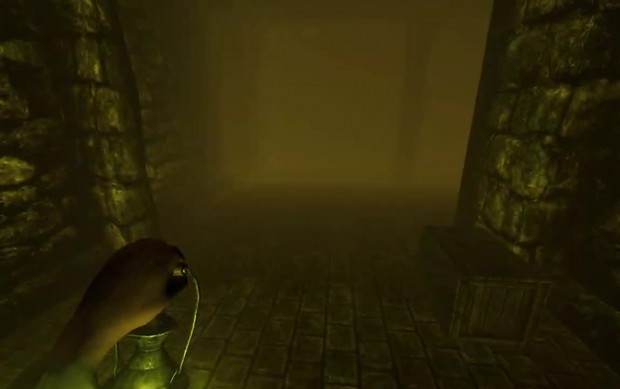 |
|---|
| One thing some modders absolutely love though is the fog feature, predominantly used to emulate dusty air or color grading. Unfortunately it often ends up looking like a dive in a septic tank |
The lack of particles effects (mostly dust in the air) might seem trivial, but these provide one of the very few opportunities in Amnesia to add “life” to the levels. Another opportunity for this is adding 3D sounds which play randomly. Skipping these effects makes the maps dead silent, devoid of movement and as a result feel extremely fake.
Moon lasers
An often hilariously misused effect are god rays (often referred to as billboards). You basically have to pose them by hand, and they usually end up looking like lasers:
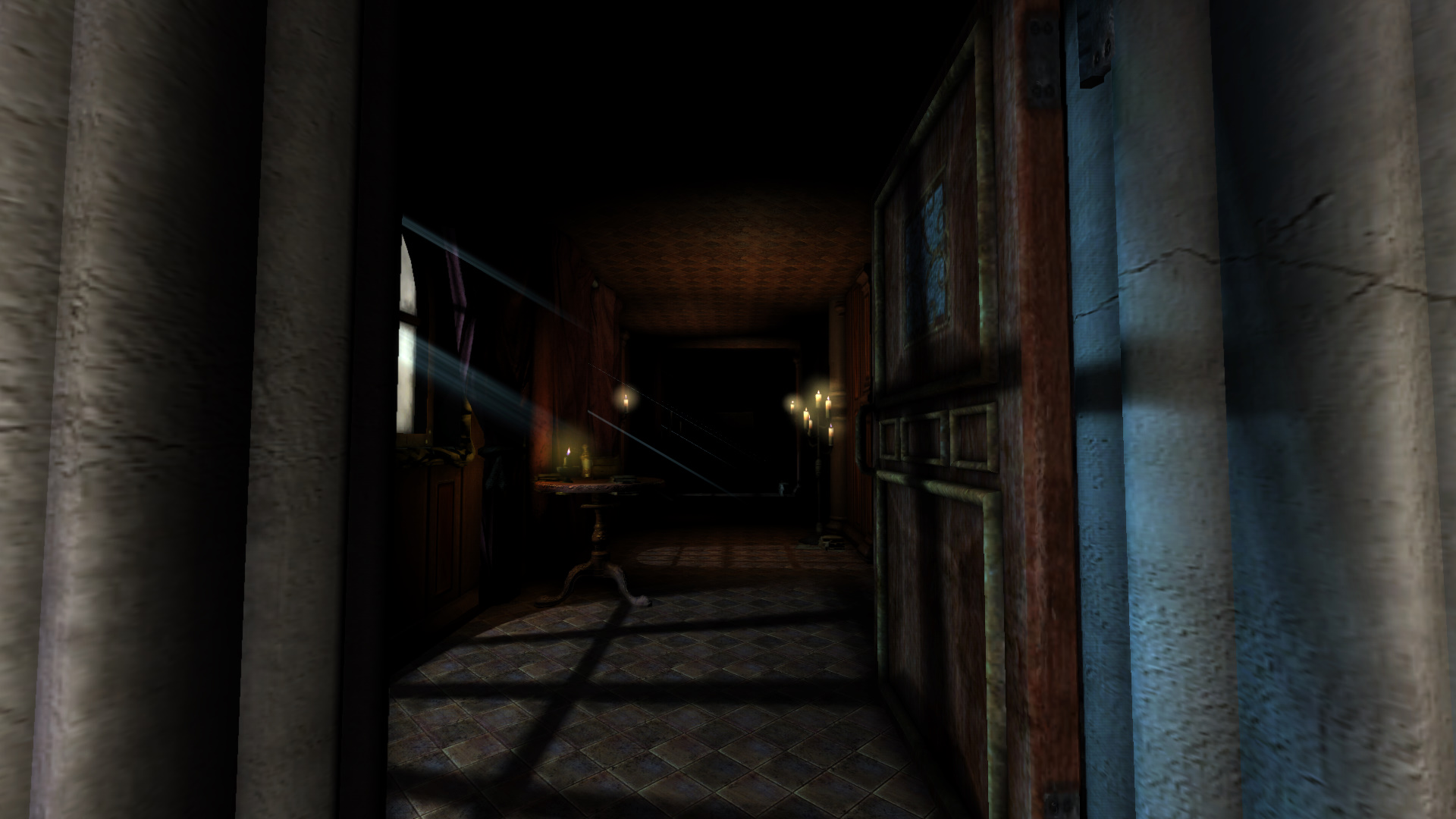
To make matters worse, the light direction and intensity is almost always mismatched. It is a prime example that some things are better left out than done poorly.
Lack of detail
As you probably figured out already, the average modder doesn’t have a penchant for details. Most mods feel very empty and superficial due to a lack of small objects, or empty chests of drawers for example.
This is further compounded by stupid level layouts and vague-purposed rooms. It is fairly common to encounter rooms which are some weird storage of unrelated furniture rather than a kitchen or a bedroom.
Custom assets
To make their mods stand out more, some modders use assets from “A Machine For Pigs”, with varying success. Sometimes they even choose to predominantly use custom assets (models and textures) from external sources, such as making them on their own. This ends up with a disaster 99% of the time (the remaining 1% is Amadeus).
Main article: Custom Assets
 |
|---|
| This is more or less how all mods set in the modern times end up looking. |
At the same time, even the most experienced modders refuse to create custom objects. The important distinction is that these objects, called entities, are different versions of the same 3D model that change how it behaves in-game. For example, a bottle model can be used as an inventory item or a static prop in the level.
So, most modders, even the good ones, never try making their own entities. What do they do instead? Try to script the object behavior, which usually ends up with crappy results. In other word, reinventing the wheel.
Scope
Most people have absolutely no idea how much time it will take them to finish their mod.
There are multiple approaches that either end in very bad mods or in a long series of “I’m still alive” updates about development progress. Sometimes both.
A result that is common between almost all of these is that the mods never get finished.
The “delusions of grandeur” approach
Many modders will set some arbitrary and unrealistically high content quota – for example, more than 2 hours of playtime or over 20 maps (main game had 29 and took a competent team years to make). Then they shit out filler levels to meet a promise they made to their non-existent audience (who would likely prefer a shorter mod of higher quality anyway). These people usually also post ridiculously precise (i.e. arbitrary and made-up) estimates of their progress. For example:
My mod is 61.5% done.
The “my masterpiece” approach
This one is extremely popular. People tend to assume that they can craft their dream story on their own, sometimes even on their first attempt at a mod. These mods are usually higher quality than the previous ones, but are more likely to never get finished.
One extreme example of this was Helena. The mod took 12 years of intermittent work to finish, and for most of that time many people thought it would never actually come out.
The scope creep
This approach is also very popular. The creators make up the story as they go. This causes their scope to expand uncontrollably.
The most notable case of this is Metus, which has been in development for over 7 years. Its creator has admitted to creating maps for the sake of creating maps, i.e. maps which weren’t planned and surve no purpose to the story. Many of the maps he showcased have no rhyme or reason in terms of the theme and the setting. The story itself went through multiple big revisions, as well as a few title changes.
 |
|---|
| Sounds good. |
The idea guy approach
Main article: Idea guys
Many modders make a few levels, announce some batshit crazy features (usually custom monsters) and request others to “help”. The mod creator has none of the skills required to implement the promised ideas, of course, and often not even the skills that are needed to make at least a basic mod. These mods never get finished.
The jogger method
These people tend to try to keep their scope reasonable or adjust their scope to match their output. Because game development is a bitch, their mods take twice longer to make than expected anyway. At least they get finished though.
The chad newbie mod releaser
This type of modder makes short mods which they finish in reasonable time, but not because they wrote a concise story and planned development well. The real reasons are that their stories are extremely simplistic and that the mod and gameplay are very bare-boned.
While most mods only feature some of the mistakes described in this article, this approach often features most of these mistakes.
Scariness
All of the above doesn’t even take into consideration that most Amnesia mods attempt to be scary.
Mods are inherently hard to make scary because the players are familiar with the models, ambiances, sounds and monsters from the base game. As such it cannot be expected that they will be horror masterpieces, albeit they should at least make the player uneasy.
However, the attempts at horror usually end at a bunch of dreadfully shitty jumpscares, monster encounters without any build-up and adding a generic ambiance to the level. Most modders don’t try to utilize sound to keep the player on edge between the big scares. In fact they probably aren’t even aware of the concept of build-up.
 |
|---|
| Scari. |
So what that most mods are bad?
Some people get angry at people who make bad mods, and some even like to roast them to hell.
Honestly though, who gives a shit that people make bad mods. God bless them for providing us with mighty keks.
Modding resources
Here are some of the key resources used to learn about modding:
- The FG forums - the original home of the community until it was flooded by spam beyond repair. It fell into disuse after the advent of Discord anyway, which also coincided with the average attention span shrinking to 90 seconds.
- Mudbill’s YT tutorials - while single-handedly allowing this community to exist, many never tried to learn more than Mudbill has shown and that’s why this wiki is a thing.
- The old modding wiki - the one most modders used, archived circa 2019.
- Frictional Games Wiki - a new, better wiki that 90% of people don’t know about, somehow. New modders who do know about it are usually too lazy to read it.
External Links
- Last Battle - One of the few mods which are so bad that they’re good.
- Horror Rebuilded - Probably the most botched attempt at modifying the base game ever attempted.
- SCP Hazardous - A lolcow of a mod that’s beyond any description
Gallery
Mods… have changed. It is no longer about originality, technical prowess or creativity. It’s an endless series of copy paste content made by people who think they are making a masterpiece. Modding, and it’s consumption of time, has become an old rusty machine. Modding has changed. Story copying, custom assets copying, level copying, setting copying. Everything is copied, and kept within static boundaries. When everyone is a beginner, copying becomes a routine.
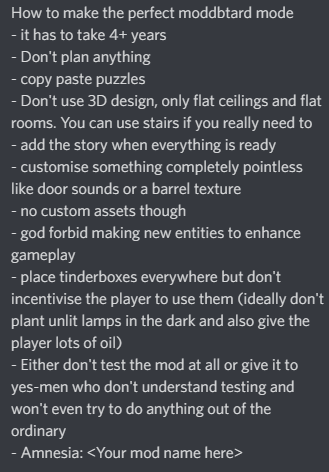
Footnotes